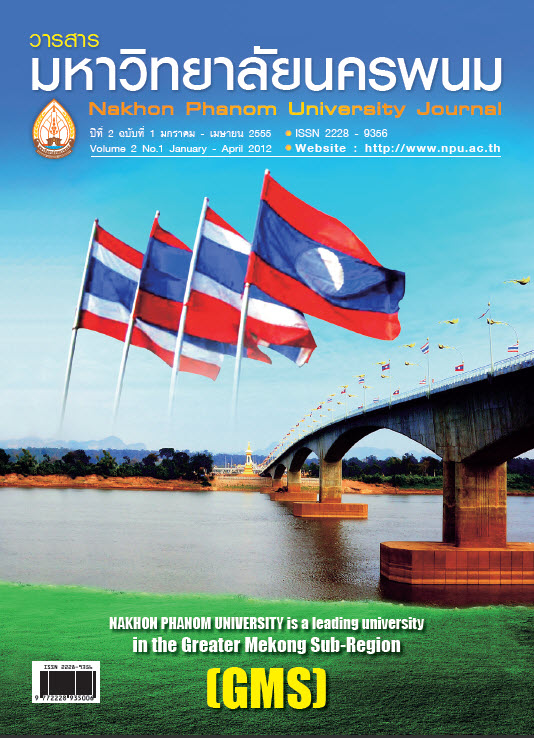การเปรียบเทียบผลสัมฤทธิ์ทางการเรียน กลุ่มสาระการเรียนรู้วิทยาศาสตร์ วิชาเคมีเรื่อง ธาตุและสารประกอบ ชั้นมัธยมศึกษาปีที่ 6 และความพึงพอใจของนักเรียนต่อการสอนที่มีการจัดกลุ่มนักเรียนและเรียงลำดับเนื้อหาสาระต่างกัน
Main Article Content
Abstract
การวิจัยครั้งนี้ มีวัตถุประสงค์เพื่อ เปรียบเทียบผลสัมฤทธิ์ทางการเรียน วิชาเคมี เรื่องธาตุและสารประกอบ และความพึงพอใจต่อการสอน ระหว่างนักเรียนที่ได้รับการสอนโดยการจัดกลุ่มนักเรียนแตกต่างกัน และเรียงลำดับเนื้อหาสาระใหม่ กลุ่มตัวอย่าง คือนักเรียนชั้นมัธยมศึกษาปีที่ 6 โรงเรียน สารคามพิทยาคม อำเภอเมือง จังหวัดมหาสารคาม จำนวน 138 คน จาก 3 ห้องเรียน ซึ่งได้มาโดยการเลือกแบบสุ่มแบบกลุ่ม (Cluster Random Sampling) แบ่งเป็นกลุ่มควบคุม 1 ห้อง จำนวน 46 คน กลุ่มทดลอง 2 ห้องห้องละ 46 คน เครื่องมือที่ใช้ในการวิจัยมี 2 ประเภท คือ 1) เครื่องมือที่ใช้ทดลองปฏิบัติได้แก่ แผนการจัดการเรียนรู้ 9 แผน โดยแบบที่ 1 เป็นแผนการจัดการเรียนรู้ที่เรียงลำดับเนื้อหาสาระที่สอนแบบปกติ ใช้กับกลุ่มควบคุม แบบที่ 2 เป็นแผนการจัดการเรียนรู้ที่เรียงลำดับเนื้อหาสาระที่สอนแบบใหม่ ใช้กับกลุ่มทดลอง 2 กลุ่ม กลุ่มที่ 1 จัดนักเรียนเข้ากลุ่มตามที่ครูกำหนด กลุ่มที่ 2 จัดนักเรียนเข้ากลุ่มตามความสมัครใจ 2) เครื่องมือที่ใช้ในการเก็บรวบรวมข้อมูล ได้แก่ แบบทดสอบวัดผลสัมฤทธิ์ทางการเรียน ชนิดเลือกตอบ4 ตัวเลือก จำนวน 30 ข้อ มีค่าอำนาจจำแนก (B) ตั้งแต่ 0.27 ถึง 0.89 มีค่าความเชื่อมั่นทั้งฉบับเท่ากับ 0.92 และแบบวัดความพึงพอใจต่อการสอน จำนวน 15 ข้อ มีค่าความเชื่อมั่นทั้งฉบับเท่ากับ 0.93 สถิติที่ใช้ ในการวิเคราะห์ข้อมูล ได้แก่ ค่าเฉลี่ย ส่วนเบี่ยงเบนมาตรฐานและทดสอบสมมติฐานใช้ F-test (One-Way ANOVA) และ t-test (Independent Samples) ผลการวิจัย พบดังนี้1) นักเรียนที่เข้ากลุ่มตามสมัครใจ มีคะแนนผลสัมฤทธิ์ทางการเรียน เรื่องธาตุและสารประกอบสูงสุด ( = 23.87, S.D.=1.46) รองลงมาคือนักเรียนที่เข้ากลุ่มตามที่ครูกำหนด ( = 22.63, S.D.=1.53) และนักเรียนที่เข้ากลุ่มปกติ ( = 20.22 S.D.=1.30) 2) นักเรียนที่เข้ากลุ่มตามสมัครใจมีผลสัมฤทธิ์ทางการเรียน สูงกว่านักเรียนที่เข้ากลุ่มปกติ และนักเรียนเข้ากลุ่มตามที่ครูกำหนด อย่างมีนัยสำคัญทางสถิติที่ระดับ .05 และนักเรียนเข้ากลุ่มตามครูกำหนด มีผลสัมฤทธิ์ทางการเรียน สูงกว่านักเรียนกลุ่มปกติ อย่างมีนัยสำคัญทางสถิติที่ระดับ .05 3) นักเรียนที่เข้ากลุ่มตามสมัครใจ มีความพึงพอใจต่อการสอนสูงสุด ( = 4.45, S.D.= 0.27) รองลงมาคือนักเรียนที่เข้ากลุ่มตามที่ครูกำหนด ( = 4.41 S.D.=0.29) 4) นักเรียนที่เข้ากลุ่มตามสมัครใจ และนักเรียนเข้ากลุ่มตามที่ครูกำหนด มีความพึงพอใจต่อการสอน แตกต่างกันอย่างไม่มีนัยสำคัญทางสถิติ
This research aimed to compare chemistry learning achievement on the issue of elements and compounds, and satisfaction on teaching methods between students in regular class setting and students differently grouped and taught lesson rearrangement. The sample consisted of 138 grade twelve students studying at Sarakhampittayakhom School, Mahasarakham Province, from three classes: 46 students from one class considered as a control group and 92 students from other two classes considered as experimental groups. They were selected by the Cluster Random Sampling technique. There were two types of research instruments used in this study: 1) Two styles of lesson plan considered as an experimental tool which were 9 lesson plans, the first style which the lessons were arranged in a conventional style, was used with the control group and the second style arranged in a new format, was used with the two experimental groups. The experimental groups were classified into two groups: group 1 was set into a group determined by the teacher and group 2 was set into a group voluntarily, 2) Instruments for collecting data: a 30-item multiple-choice learning achievement test with a discrimination value (B) at 0.27 - 0.89 and a reliability of 0.92, and the 15-item questionnaire of satisfaction on the teaching and a reliability of 0.93. The statistics used for analyzing data were mean, S.D., F-test (one-way ANOVA), and t-test (Independent Sample). The results were as follows: 1) Students who voluntarily attended the class gained the highest achievement score in the issue of elements and compounds ( = 23.87, S.D.=1.46), followed by the students who attended the class as determined by the teacher ( = 22.63, S.D.=1.53) and the regular group gained the lowest score ( = 20.22, S.D.=1.30), 2) Students who voluntarily participated in the class gained higher learning achievement than those of the students in the regular class and they were determined by the teacher at the significance level of .05. The students who attended the class as determined by the teacher showed higher achievement in the issue of elements and compounds than the students in the regular class with of the significance level of .05, 3) Students who voluntarily attended the class had the highest satisfaction with teaching ( = 4.45, S.D.=0.27), followed by the students who attended the class as assigned ( = 4.41 S.D.=0.29), and 4) Students who voluntarily attended the class and students who attended the class as assigned by the teacher had no differently significant satisfaction on teaching methods on elements and compounds topics.


